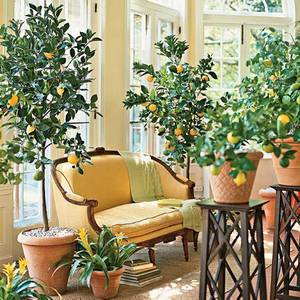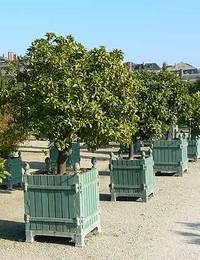Compared with many plants, the seeds of most Citrus species are relatively large and easy to handle. If they are sown in an ‘open’ seed compost in a brightly lit position with a temperature around 15ºC, they should germinate within two or three weeks. However, it will take several years before they start producing flowers and fruit.
· In addition to propagating plants from seed, they can also be increased by cuttings. Heel cuttings between 100-150mm in length can be inserted in moist sharp sand at a temperature of 21ºC and kept as humid as possible until the roots form – which should be within a couple of months.
· Citrus plants do not like lime, so when the seedlings are large enough to be potted-on they should be planted into a pot containing ‘ericaceous’ compost, preferably a soil-based one such as those developed by the John Innes Institute. The optimum pH for the compost is 6, which is slightly on the acidic side of neutral.
· During the growing season, from spring through summer, the plants will benefit from the regular application of a nitrogen-rich fertiliser to boost strong growth. Once winter is upon us the occasional feed with a balanced fertiliser would be beneficial and help to keep the plant healthy.
· Although your plants will need plenty of water in hot weather, they should not be allowed to become water-logged as this will kill off the roots and their foliage will drop. Similarly, if they do not receive sufficient water, the flowers will fall and the foliage will shrivel.
· It is customary for large pots of Citrus to be placed in a sheltered spot in the garden once all danger of frost has passed.  Although they will receive rain, the foliage will often act like an umbrella and the rain will run-off without wetting the compost, so a check should be made regularly to ensure that the compost is moist.
Although they will receive rain, the foliage will often act like an umbrella and the rain will run-off without wetting the compost, so a check should be made regularly to ensure that the compost is moist.
· The best type of pot is one made from terracotta; it is easy to tell by tapping its side whether or not the compost is dry. A dry clay pot will have more of a ring to the sound when tapped than a wet pot and they are less likely to become waterlogged than plastic ones. The main drawback to these clay pots is their weight which can be several times that of a plastic pot.
· Ornamental rectangular containers, modelled on those which were used for growing Citrus at the garden of Versailles, can be made or bought but consideration must be given on account of their weight and size to moving them into a protected space once there is any danger of frosts.
· The best water for watering your Citrus will be clean rainwater as this will not have received any chemical treatment that could be detrimental to the plants. If insufficient rainwater is available, the use of ‘soft’ tap water is preferable to ‘hard’ water which contains calcium which will leave unsightly deposits on the leaves.
· Orangeries, such as the fabulous ornamental building here at Margam, were originally used to give winter protection to Citrus trees; they do not allow enough light to get to the plants for them to grow healthily throughout the year. Plants should be kept in as bright a location as possible.
· As long as there is some air movement and they have moisture at their roots, orange trees will be happy in the hottest of summer temperatures. However, in early autumn, as soon as the temperature begins to fall, the plants must be moved into a space where the temperature does not fall below 8 or 10ºC, nor rise much above 15ºC. They should be kept in this mild environment through the winter until all danger of frost has passed. This will normally be at the end of May or early June.
· Pruning is not normally necessary but if the growth is weak or the bush is misshapen or outgrowing its space, the branches can be shortened back in the spring.